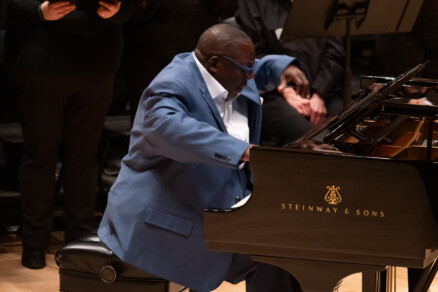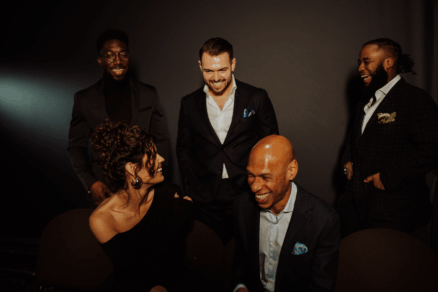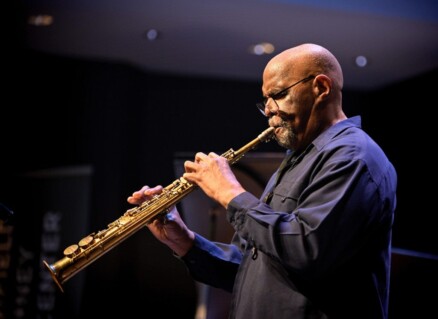Live review | Bloodsucker jazz: A quiet legend, a percussion master and a vampire movie


by Luke Stewart
Editorial board
Edward Wilkerson, Jr. and Tatsuya Nakatani
Freer Gallery
Wednesday, April 3
Adding film or other visuals to improvised music can sometimes be a clever way of drafting a focus point for sounds that might be too meandering and esoteric to stand up on their own. For Edward Wilkerson, Jr. and Tatsuya Nakatani, it works the opposite way. In a performance at the Freer Gallery last week, they offered improvised accompaniment to a plodding, slightly overwrought film, and it made the experience not just bearable, but enthralling.
On Wednesday, April 3, at the Freer’s Meyer Auditorium, the two expert practitioners of avant-garde music performed in support of Sanguivorous (2012), the first silent vampire movie by a Japanese filmmaker (by some accounts, the first Japanese vampire movie at all). Their music was so touching that the film all but morphed into a backdrop for these two gurus of improvised sound. Sanguivorous – Kyuketsu, in Japanese – was written and directed by Naoki Yoshimoto, and clocks in at a deceptively long 56 minutes. The movie wasn’t initially intended to be accompanied by live music, but with the treatment from Nakatani and Wilkerson, it became difficult to imagine it without their playing.
The pair couldn’t have been more complementary of each other. Wilkerson is a saxophonist and a lesser-known legend in the making, who developed in Chicago under the nurturing umbrella of the AACM (Association for the Advancement of Creative Musicians), where he served as president and participated in several creative ensembles. He’s a master not just of his main instrument, or of the jazz tradition; he is a true multi-instrumentalist, and draws inspiration from many cultures and traditions. He brought his tenor saxophone, Bb and alto clarinet, didgeridoo, and a table full of assorted percussion instruments – complete with bells and whistles, literally. In the question-and-answer session after the performance, he exhibited his instrumental arsenal and explained: “In different cultures, musicians use different instruments to represent different parts of the body.”
Nakatani is a devoted musical wanderer. The Easton, Pa.-based percussionist and instrument-maker travels the world many times every year, performing in different situations as a soloist and collaborator with various ensembles, including his celebrated Nakatani Gong Orchestra. He utilizes an array of instruments, including singing bowls, bells and homemade sticks and noisemakers. At the front of his drum kit sits his iconic gong, which he often bows to create the shrill metallic sound that is familiar in horror films.

Wilkerson and Nakatani meld in the best way. Both are deeply rooted in their musical traditions, and both are continuously developing their improvisational concepts, picking up new little instruments throughout the show. The duo is touring this presentation, so they’ve seen the film many times, but each performance is an improvisation. They have become familiar with the scenes and passages, allowing for a conceptual structure. As the two improvised over the film, one got the sense of two artists exploring the full breadth of their sonic options. At times they would play softly, at others almost deafeningly in a passionate but calculated flurry of sound. The live music made the film much more intense, largely rescuing it from the realm of the campy vampire movie. Most of the film was dark and slow-moving, lacking stark visuals, but there were some moments when the movie and the music meshed very well.
At the beginning, Wilkerson donned his tenor as Nakatani played in perhaps his most conventional mode: drumsticks against the drums. The film’s opening shot was of a cityscape, and Wilkerson blew the urban blues, Chicago-style, that’s translatable worldwide. Nakatani was constantly busy, and his “conventional” sojourn was short. Before the scene could change, he pulled out his cymbals and bells, starting in on a continuous fidgeting with his instruments. Often he would play Taiko-like passages, as are found in classic Samurai films, fitting the context appropriately.
The intensity flowed and swayed masterfully as the duo fixed their eyes on the screen, reacting to each scene. Often, the music overpowered the film as the artists themselves were moving around and doing so much. Their fervor, not the film, became the focus. Overall, the experience was extremely moving and innovative. The two maestros displayed the diversity of acoustic improvised music, and implied the openness of the possibilities that remain to be explored in fusing music and film in a live setting.
DC, DC jazz, Edward Wilkerson Jr, Freer Gallery, jazz, Kyuketsu, Sanguivorous, Smithsonian, Tatsuya Nakatani, Washington




